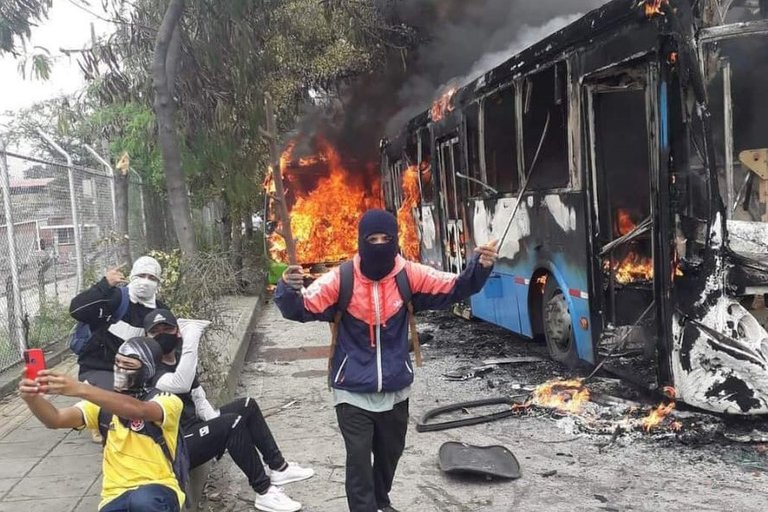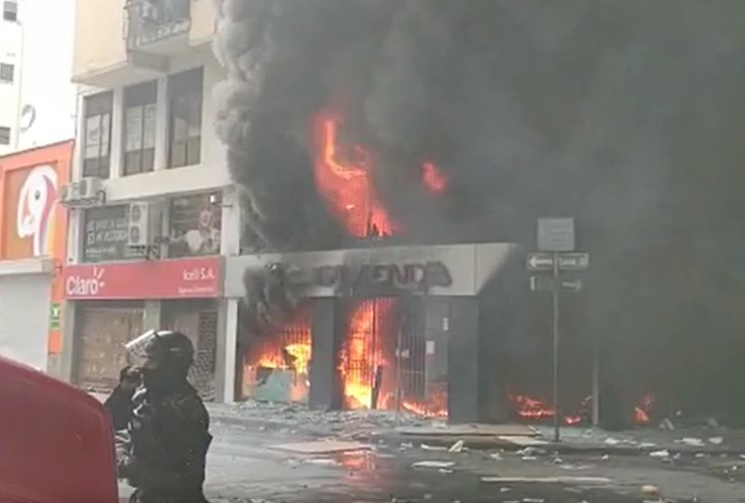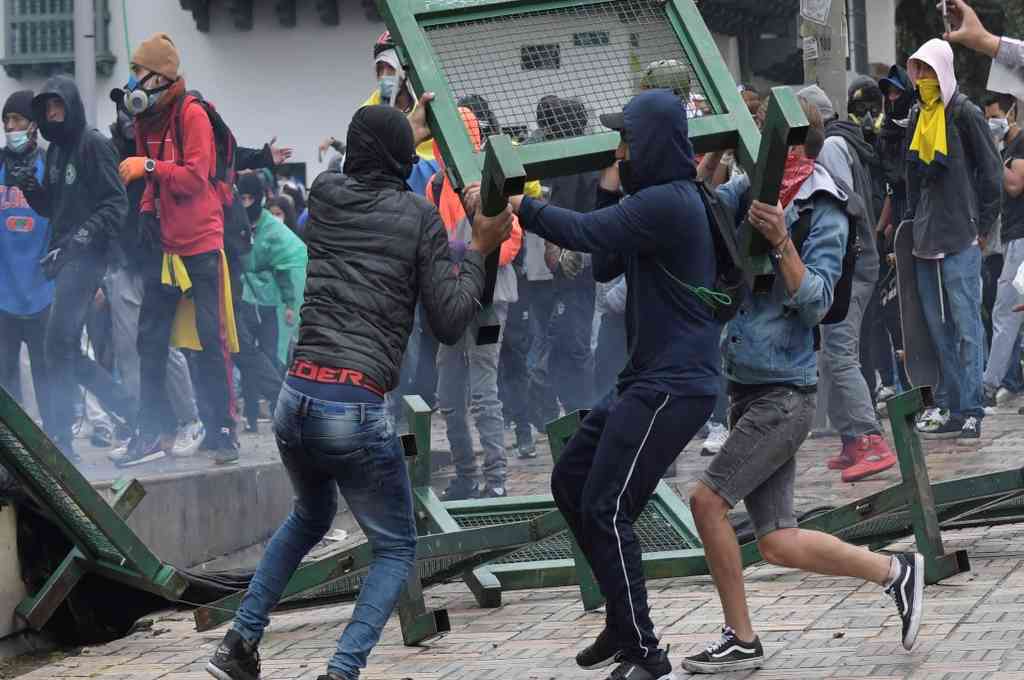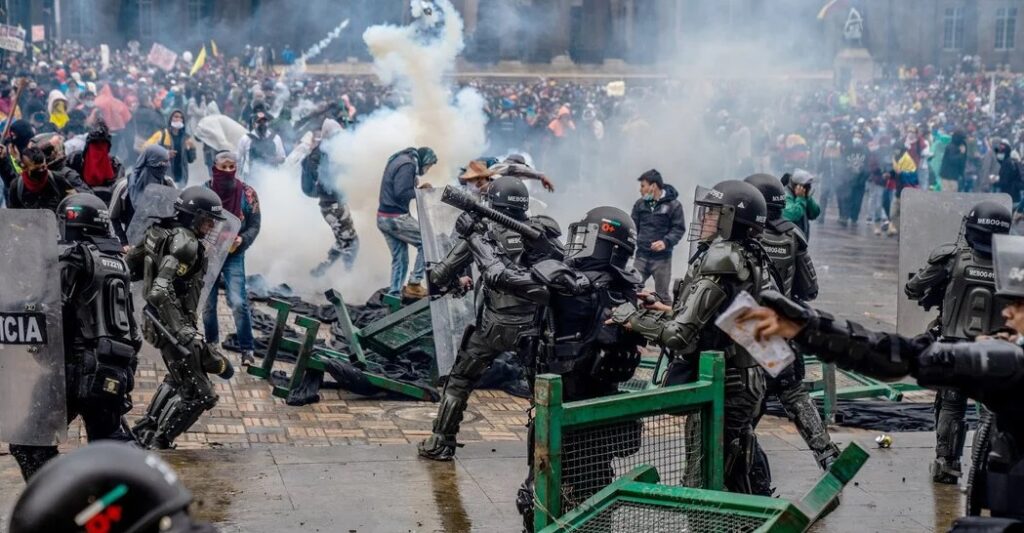Protesters must look beyond the 2022 poll if the change they seek has a fighting chance
If you’re not outraged, you’re not paying attention.
– Heather Heyer
***
With each passing day, the crisis in Colombia mutates. The tone and context change. Competing narratives expand and contract. The conspiracy theories pile up, people get meaner and claim to know what their adversaries – either on the streets, on Twitter, in congress – are thinking. There has been only a few constants: street battles, bullets, blockades and bloodshed.
If you think that the protests have subsided because the National Strike Committee has called them off, you’d be sadly mistaken.
Whether you believe the national strike (popularly known as the paro nacional) is to blame for the crisis Colombia currently finds itself in, or whether it’s the fault of the Duque administration, depends not on the facts, but on your political persuasion.
Facts abound, and they can be emphasized, ignored, or reassembled in order to suit one’s confirmation bias. I’ve seen the same set of videos pop up in the strangest places. Videos that have been used to defend the national strike, are sometimes the very same videos the opposing side uses to condemn it.
If we sift through the spin, a number of principal actors emerge, and they can be separated into two camps. In the first camp, we find anti-government activists, leftists, student radicals, wannabe revolutionaries, champagne socialists, and NGOs. They rightly point out that at least 73 people (and counting) have died as a result of the protests; 55 of those (and counting) were civilians killed by police.
At least 10 more have died at the hands of armed extremists in civilian clothing, mostly in the city of Cali. They have been filmed standing shoulder-to-shoulder with police, firing pistols and rifles at demonstrators, or doing drive-by shootings from the windows of their expensive SUVs.
Cali resident Andrés Escobar seen pointing and firing a pistol at protesters last month.
No cesa la horrible noche: En la luna y el paso del comercio en Cali, una camioneta blanca disparó a los manifestantes desde las 7 de la noche.#SOSCaliDDHH#CaliEnAlertaRoja#CaliEnPeligro#PAroNacional7M pic.twitter.com/XF4HpX5bJx
— Diego Cancino – Concejal de Bogotá (@cancinodiegoa) May 8, 2021
The driver of a white SUV seen hanging out of his window and firing gunshots, in Cali, on May 7.
Hundreds more have lost limbs and eyes to the ESMAD riot police’s rubber bullets, or suffered brain damage after being shot point-blank in the head with teargas canisters. Still others have received gunshot wounds after the police – or their shady civilian gunmen allies – opened fire on crowds of people.
The protesters aren’t angels, mind you. Responding to vandalism and rock throwing with gunfire is usually seen as excessive. But police and civilian gunmen who’ve shot at protesters enjoy such a level of impunity that one must wonder if gun violence is still considered a crime in this country. Just ask Andrés Escobar.
(To any Colombian lawyers reading this, what’s it like dedicating your life to the practice of law in a place where the law is almost never enforced? How do you square that circle?)
For women involved in the protests, a special kind of horror has been in store. There have been two-dozen reports of women who were raped while in police custody. Those are just the reported cases; the real number is likely to be much higher.
In one of those cases, a 17-year-old girl committed suicide a day after she was detained and allegedly sexually assaulted by police in the city of Popayán.
If all that weren’t bad enough, close to a thousand people have been detained by the police since the protests began, and hundreds of those have not been seen or heard from since. When someone gets ‘disappeared’ in Colombia, it sometimes means they’re dead. And bodies have already begun turning up – mutilated corpses fished out of rivers, heads and other body parts found in roadside ditches, and chopped up bodies discovered in dumpsters outside hospitals in Bogota.

Left: Three bodies (one not pictured) found wrapped in plastic on a roadside on Medellin’s outskirts, on June 20. Center: A severed head of an unidentified woman in a plastic bag, found beside a dumpster in the Kennedy district of Bogota, on May 21. Right: Another head found in the town of Tuluá, Valle del Cauca province, on June 21. The head was that of 22-year-old Santiago Ochoa, who was reported missing two days before.
In the second camp – made up of those who oppose the protests, sometimes with live fire – we find the usual suspects: uribistas, the Duque administration, the rich, ruling elite, far-right ideologues, and a mish-mash of fascists and extremists. We also find people who have nothing to do with the Colombian right, yet occupy the same tent: a significant portion of the working poor.
If this group opposes the national strike, it’s not because they support the government. It’s because much of the public transportation they rely on to earn a living has been taken from them. In Bogota alone, 139 TransMilenio bus stations have been vandalized during the national strike, and of those, 53 have been rendered inoperable. There are 200 fewer buses able to move people around the city, either because they’ve been damaged, or charred completely to a crisp.
Most of these acts have been carried out by what are known as encapuchados – roaming bands of militant students, ñeros, petty criminals, violent thugs and degenerates – young men whose only politics is a lust for destruction.
What they do isn’t protesting at all. When these hoodlums loot shops, torch city buses, police kiosks, and reduce TransMilenio stations to seas of broken glass – they’re not doing damage to the powers that be. What they are doing is giving legitimacy to the state’s heavy-handed and deadly response – towards them, and towards peaceful protesters who have real and legitimate political demands.
Related: The Death of Hope in Colombia
The vandalism and destruction hurts the poorest and most vulnerable the most: Those who are already suffering and starving as a result of the Covid-19 pandemic.
A maid who lives in the south of Bogota and works in the north now has a hard time getting to her place of employment. Unlike much of the middle class, she cannot do her job from a laptop computer at home. The bus she needs to take every day has been destroyed, and the TransMilenio station closest to her home has been trashed. She then faces a tough choice: walk two hours or more to reach another station and pray that buses are running – or give up on the whole endeavor and stay home. The latter option might mean she and her children don’t get to eat that day.
It’s little wonder then, that vast swathes of Colombia’s working poor are sick-and-tired of all the chaos the paro nacional has kicked up.

Protesters take selfies next to burning buses in Cali, on May 11.

A Davivienda bank branch in Cali burns during the first day of the paro nacional protests, on April 28.

Protesters in Bogota throw a steel barricade towards ESMAD riot police, on May 12.
Road Blockades as Sanctions
Like them or loathe them, the road blockages that were found in-and-around most of Colombia’s major cities were a political tool that actually caused damage to President Ivan Duque and his government. The people and groups who were blocking the roads, and their demands, were as varied and diverse as the regions in which they were found.
The truckers’ union blocking the main arteries outside of Bogota wanted one thing, while the roadblocks set up by working-class, unemployed young people and indigenous protesters along the Pan-American Highway outside Cali were demanding something altogether different.
Much like the economic sanctions the US imposes on nations it doesn’t like, the road blocks did even more harm to the poorest and most vulnerable in society. The rulers may suffer in the opinion polls, but the bellies of the poor rumble at the sight of what they can no longer afford to put in their refrigerators and cupboards.
The general idea behind any set of economic sanctions is to damage the country’s economy, and to amplify the misery of the people, in the hopes that they will rise up and overthrow their rulers – or at least pressure them into seeking concessions. But if Venezuela has taught us anything, it’s that people – rather than overthrow their governments – preoccupy themselves with the daily struggle of getting enough food to eat.
Related: Colombia: The Next Domino to Fall in the ‘Latin Spring’?
The economic effects of the roadblocks were not unlike those found in rogue states under economic sanctions. They’re microcosms felt in the areas directly impacted by each unique blockade. The food shortages and price spikes on basic stable goods were there for all to see.
The blockades also have had lethal consequences.
In Bogota, for example, the dire situation was exacerbated – or at least brought to light – after leftist city councilwoman, Heidy Sánchez, posted a video purportedly showing an ambulance being used to deliver ammunition and other supplies to the ESMAD riot police.
The video shared by Sánchez on social media enraged the protesters tending to the blockades, and many began demanding ambulances be searched before they were allowed to pass, while others banned such emergency vehicles from passing altogether.
Colombian protests continue: Leftist politician accused of turning mob against ambulances https://t.co/YPrN6O916V pic.twitter.com/HLMfYLID1L
— WPLG Local 10 News (@WPLGLocal10) June 3, 2021
As a result, an infant baby died on route to hospital in the ambulance he was traveling in, and others have died under similar circumstances as a result of the roadblocks. Countless others suffer in their homes, doing without radiation treatment for cancers, dialysis for people suffering from kidney diseases, or intensive-care beds for Covid-19 patients.
Blockades Down, But the Paro Goes On
Most of the blockades have come down, largely as a result of the National Strike Committee calling for them to be lifted, despite the fact that Duque and his government have refused to reciprocate the olive branch by meeting any of the committee’s demands.
They have also suspended daytime marches that have been held almost daily since the end of April, having acquiesced to the idea that such marches are exacerbating the spread of Covid-19. But the violent nighttime confrontations between police and militant protesters – a group that the Strike Committee has no control over – continue unabated.
And so too do the fatalities. Just four days ago, a protester in the south Bogota district of Usme died after he was shot in the chest with a tear gas canister.
The same night, a young man in Cali died after being shot in the head with a firearm. Riot police were sweeping through the protest stronghold known as Puerto Resistencia (Port Resistance), and clashes between demonstrators and police ensued. The ESMAD used so much tear gas in the altercation that it wafted into nearby homes and poisoned three children, including a 2-month-old infant. The children had to be rushed to hospital.
For now, the Strike Committee is trying a new tactic – working with NGOs and civil society groups to draft legislation they can present to Colombian Congress. The plan is meant to bypass President Duque, whose stubbornness has brought the negotiations to a halt.
And when that inevitably doesn’t work, we can expect another wave of marches, and fresh scenes of chaos, violence and death. The strike committee has already called another nation-wide protest for July 20th – Colombian Independence Day.
***
The national strike, like Colombia itself, is riddled with contradictions. It needs to come to an end. The economy needs to pick back up, food prices need to come down, and hospitals and healthcare centers must start operating at full capacity again.
But paradoxically – out of respect for those who have died, those who’ve lost eyes or limbs, and those who have been raped and abused – the strike also needs to keep on going.
If Colombia rides this out until the presidential election 14 months from now, it’s only going to prolong the unrest. People may get excited by the prospect of a new leader, but sadly, little of the kind of change the country needs will be found at the ballot box. At least not this time around.
Colombians could elect a cynical careerist who doesn’t know how to govern, or opt for another Uribe hand puppet. Maybe this time they decide to give the reins to some son or daughter of the ruling elite. It probably doesn’t matter all that much who they pick. The next president has very little chance at seeing a majority in congress, so it’ll be like slapping a fresh face on the same old gridlock.
Sergio Guzman, director of the political consultancy firm Colombia Risk Analysis, stated recently that solutions to Colombia’s social unrest are in short supply. What is almost certain is that the same old slate of establishment politicians – on both the right and the left – won’t be the ones to introduce the broad-sweeping changes that Colombia so desperately needs.
If the protest movement is looking for a path forward, they need only look to the grand political project currently taking place in Chile. The protest movement there gave rise to new leaders and political parties. These fledgling movements formed coalitions, and thoroughly routed the old established parties in local elections that took place in May. Chileans also cast ballots to seat people in a new Constituent Assembly, which will be tasked with rewriting their constitution.
The Chilean election results were an indictment of the country’s political class, those entrenched elites who for years used politics as an instrument to defend and expand their wealth and privilege. Sound familiar?
Colombia’s corrupt political class deserves a similar kind of reckoning. And the national strike movement – messy, chaotic and nebulous as it is – just might represent the best chance at achieving this.

Journalist. Misfit. Malcontent. Provocateur. Is a better Colombia is possible? We’re starting to have doubts.

